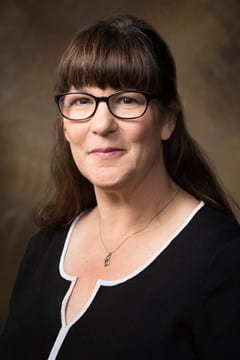Rachel Glade and Lynn Meade presented on Creating Safe Spaces for Discussion for the TFSC New and Not-So-New Faculty Lunch Series.
 |
Rachel Glade, Clinical Assistant Professor, Speech & Hearing Clinic Rehabilitation, Human Resources & Communication Disorders, President of Arkansas Speech-Language-Hearing Association |
 |
Lynn Meade, Instructor in the Department of Communication, Imhoff award winner for teaching excellence |
Why Don’t They Speak?
The first subject that was discussed was the reasons that students might not be willing to speak out during class. Research says that the most common reasons are as follows:
- Discomfort with conflict.
- Worry about how others will see them.
- Fear of lower grades if they disagree with the professor.
- Not feeling that they know enough about a subject to talk about it.
What is a Safe Space?
An environment in which students can discuss challenging issues without fear of criticism, threat, or bias.
Managing Conflict to Create a Safe Space
Conflict is often going to exist in a class, especially when a controversial subject is raised. It shouldn’t be discouraged, but it should be allowed to thrive in a civil environment in which the thoughts and opinions of others are respected.
- Set expectations for civil discourse early. We will have disagreements and that is perfectly acceptable. The important thing is that we can discuss the subjects about which we disagree without turning it into a shouting match and without insulting the other person.
- Put these expectations down in the syllabus.
- Explain the consequences of breaking from these expectations clearly. A suggested consequence could be to write a paper that discusses the subject from both viewpoints.
- Teach the students to separate ideas and the person discussing those ideas.
Creating Brave Spaces
- Provide a certain number of “passes” during the semester. If there is a subject that they don’t feel comfortable talking about because of any reason, allow them to pass on a discussion.
- Help the students feel like they’re part of the course by using diverse names and clipart.
- Give positive feedback for all types of comments. At least they were willing to share their opinion. If someone says something completely inappropriate, first affirm their willingness to share, and then say “Yes, others think that way, but…” and follow it up with a reasoned response.
- Create opportunities to get to know your students. They will be more willing to speak if they are comfortable with you and their classmates.
- Another way to make them feel comfortable is to have each of them create a notecard with their name and something they are interested in. Try to work those topics into the conversation to help them blossom into the discussion.
- Create groups with differing opinions to encourage challenging conversations, then start them off with an assignment that requires research so that all of their arguments can be backed with citable facts instead of just opinions.

If you would like more information on how to incorporate technology into your courses, reach out to us at tips@uark.edu.
For more information on Rachel Glade and Lynn Meade’s topic, the presentation can be downloaded and viewed as a PDF: Meade Glade_Creating Safe Spaces for Discussion or you can email them at rglade@uark.edu and lmeade@uark.edu respectively.
This content was developed from a presentation by Glade and Meade which was sponsored by The Wally Cordes Teaching and Faculty Support Center (TFSC) at the University of Arkansas.